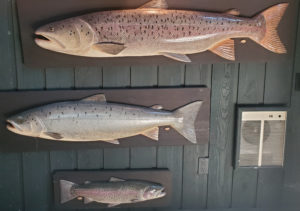Really looking at any trout is difficult.

Atlantic Salmon and rainbow trout
From above to bird predators the always dark backs look like shadow lines in their streambed rock jumbles. To bankside observers, on four feet or on two feet, they disappear beneath flexing currents’ water top mirrors.
And even for some fly fishers, who have a trout brought to hand, the fish itself is gone before it can be studied. About eight percent of trout releases die from the catch experience. For many adepts, and here at least I am an adept, each of our magic trout caught deserves its best chance to be in the ninety-two percent. And so, as good science advises, we unhook them fast as possible still in the water. Our trout are gone faster than our vision.
Frank in his first time in Ruin out fishing has not evolved to this code of conduct. He naturally wants to study his 18-inch surprisingly toothed first brown trout. Mid-day helpfully turns up light intensity for him. The fish is regarded as if a painting on a museum wall. The sun-yellow belly and ventral fins with white edge. Up at the back solid dark brown with brown-dot gray dorsal fin. And then there is the explosion of colors on its slab side—vivid to Frank though that would be dim in a trout’s range of color distinction. Colors arrayed distinctly as computer coding taps, a spangle of ruby-centered white aureole dots float spaced all along the flank as it shades from yellow up to gray up to brown. Dark-centered dots merge up into the solid dark ground of the fish cylinder’s top.
Frank is properly in love at first sight. But he has no conception of what he holds in his hand. Because this one trout, like all of them around the globe, is an image tapped out by a code of unreachable complexity over constantly evolving time. Scientists, the ichthyologists and biologists, cannot reconstruct that code into satisfactory Linnean specie boxes. The range of variations within even one small geographic area is both too great and is constantly re-iterating. This is true especially in this last hundred years as globality mixes populations together. That engenders hybrids, which some of us try to forestall and some of us value for pragmatic reasons.
And then more complexity. With modern sampling it is revealed that individual trout sometimes try painting their own identity differing from their brethren swimming right beside them. Why? That would be what makes the world go around for fishers too … sex and fear of death.
So modern science largely has moved away from past centuries’ certainty of lineages of trout. It seems pointless to many. They consider the myriad of beautifully painted hyper-local variant expressions evolving sometimes rapidly over and over during and after multiple Ice Ages.
In Ruin Frank the noble savage fisherman, enjoined by his magus Dr. Arbuthnot to not read about fishing at all, won’t have time to learn trout taxonomy before life carries him so rapidly away.
But if a time comes for Frank, he could do what I have done to appreciate the complex beauty of all the world’s trout species and their cousin fish. He could sit down in an Adirondack chair in the shade with a bottle of beer some locals tried to brew and open James Prosek’s Trout of the World and look and look and smile. This artist literally traversed the globe for six years, finding specimens and painting them in watercolors that capture the subtlety of symphonic color shading trout are all about. There are 120 individual trout in Trout of the World. But as James says, the book constitutes a single statement about diversity. That is said with a deeply talented paintbrush and a deeply serious vision of nature. Touching for me that in our friendship James patiently indulged my notion for the cover of Ruin, which, for this novel about losing it all, was to take one of his most lovely paintings and float it upside down in a sea of money-negative red, to convey this is a story about things going belly up. Now, that is an indulgent friend who I am lucky indeed to have.
